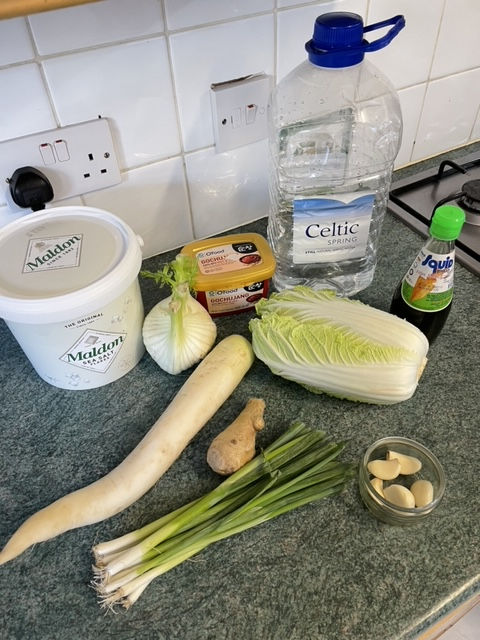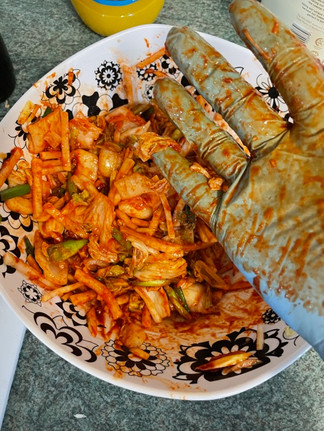The Lazy Scientist makes Lazy Kimchi
- Sen5es

- May 7, 2021
- 5 min read
Welcome to our first ever guest blog! We are pleased to share this awesome post written by Steve over at the Lazy Scientist.
In case you don't know, the Lazy Scientist is a hot sauce company based in London. Established in Brixton in 2018, it boasts some impressively hot sauces. You can learn more in our customer spotlight blog where we interviewed Steve all about his hot sauces and business.
Steve was kind enough to share his Lazy Kimchi recipe which you can find below. This recipe is so simple and easy to do. It also tastes amazing and the Kimchi can be used in so many dishes.

What is Kimchi?
Kimchi is one of my absolute favourite ferments to both make and to eat! The Korean staple is thought to have originated around 100BC as a culmination of the centuries old preservation methods already in use by families to get them through the harsh winters and has now grown to be a worldwide delicacy loved by millions.
It is a traditional side dish of salted and fermented vegetables. With a base of napa cabbage and Korean radish and with added seasonal vegetables, spices and other ingredients.
As with many traditional dishes there are thousands of different recipes depending on region and availability of ingredients but the method is fundamentally the same throughout. Kimchi is simply a dish of salted and fermented vegetables with the addition of a few common Korean staples.

Steve’s Lazy Kimchi Recipe
I’ve chosen to go with the cheat version I came up with a few years ago. This recipe is based on the fact I always have a pot of Korean Gochujang or Korean red pepper paste in my fridge. I tend to have this delicious substance on hand at all times as it works great in a variety of dishes; from stir fries all the way to putting an Asian spin on the classic roast chicken!
As previously mentioned, this recipe can be adapted to include pretty much any vegetable you have around, I’ve even thrown in fennel and green beans on occasion so let your imagination rip!
Ingredients
Will make about enough to fit nicely in a 1litre Kilner or Jam Jar.
1 Napa Cabbage
¼ Cup of Sea Salt
Approximately 250 - 500ml filtered or Spring Water (anything that doesn’t contain chlorine as this inhibits the fermentation process)
½ a Daikon Radish cut into matchstick strips (or use a couple of carrots instead)
3 minced cloves of garlic
1 thumb sized piece of Ginger, peeled and finely cut
4 Spring Onions cut into 1-inch pieces
¼ Cup Gochujang Paste (not vegan) or 3 tablespoons Korean Red Pepper (Gochugaru) flakes if you follow a plant based diet.
2 Tablespoons of fish sauce (can swap for vegan fish sauce, Miso paste or soy sauce to taste)
Optional extras
Carrot
Apple
Green Beans
Fennel

Equipment
Mixing bowl
Saucer
1l Glass Kilner Jar or other similar size jars with lids
A chopping board and knife
Garlic Mincer
Rolling pin or similar object to help pack kimchi tightly into the jar!
Method
1. SALT THE CABBAGE (6 hours)
Reserve 1 - 2 outer leaves for later then cut the cabbage into inch size pieces and place in a mixing bowl. Toss with salt and add enough water to cover before stirring to dissolve all the salt. Place a saucer on top to keep the cabbage submerged and leave at room temperature for about 6 hours or even overnight if easier.
2. DRAIN THE CABBAGE, SAVE THE BRINE!!
Give the cabbage a quick rinse and squeeze out the excess water before placing back in the bowl and adding your Daikon radish, ginger, spring onions, garlic, Gochujang paste and fish sauce.
3. MIX IT UP
Massage all the ingredients together thoroughly using your hands (or spoon if you want less mess…)
4. PACK INTO A SUITABLE JAR
I cram mine in and then pack it down tightly with an old rolling pin to ensure there are no air bubbles. Make sure you leave around 1-2 inches room at the top for any juices that are released. You can then place your spare cabbage leaves on top and press down before carefully pouring a bit of the brine you saved from earlier on top.
You just need to make sure everything is submerged below the liquid as anything above is susceptible to mould. I’ve had good results using, fermentation weights, small jam pots or even a Ziploc bag with some water in to do this too.

5. FERMENT (4 days minimum)
Place the lid on tightly and leave at room temperature for a few days. I like to leave mine visible on the kitchen counter so I remember to burp it once or twice daily.
To burp you simply unscrew the lid a fraction to release any of the gas that builds up during the fermentation process and then re-tighten.
After a couple of days you should see lots of bubbles forming in your packed vegetables. This is completely normal and a good sign that your Kimchi is working!
6. STORAGE
After 3-5 days your kimchi should be ready to eat, however I find that leaving it to mature for at least another 2 weeks really adds to the complexity and flavour.
The longer you leave it, the more tangy it will become.
Taste it after 4 days and see what you think. If you’re happy with the flavour it’s now time to move it to a fridge. This will slow down the fermentation process but be sure to check it every couple of days so that any gases are let out and prevent your Kimchi from becoming fizzy.
Your Kimchi will last for months this way in the fridge and continue to ferment slowly while the flavour continues to develop.
7. SERVING
Serve Kimchi as a side dish by scooping out with a fork and adding to rice or noodle dishes, soups, on burgers or just eat straight up as a snack.
Don’t chuck the liquid you are left behind with away though, this can be used as a fabulous salad dressing or added into a whole host of dishes.
Feel free to experiment for yourselves and let us know if you find any absolute winning combinations!
Steve's top tips
No Bubbles after a few days?
Move to a warmer area of your home and you should see bubbles soon.
Have you found mould?
Sometimes if too much air gets in during the fermentation process you can get a bit of white mould forming.
No Biggy, carefully scrape it out and then make sure everything is pushed back under the brine again. Once the fermentation process has started the acidity will drop quickly and the Kimchi becomes shelf stable and safe from this problem.
How to use!
One of my favourite uses for delicious fresh Kimchi is to make Kimchi Ramen!
Fry up a couple of chopped Shiitake mushrooms and handful of chopped Kimchi cabbage for a few minutes before adding in a glug of kimchi juice, tablespoon roasted sesame oil, teaspoon of chilli powder, pinch of sugar and 500ml stock. Boil for five minutes before pouring over precooked noodles and adding on any toppings you like. My go-tos are spring onion, a soft boiled egg, coriander leaves and to really finish it off in style; some thin slices of Scotch Bonnet chilli... I just can't help myself!
Thanks for taking the time to read this recipe; I hope you’ve enjoyed it as much as I have creating this post for the wonderful humans at Sen5es Bottles. I'd absolutely love to see the results if you give it a try for yourselves at home. Just tag @lazyferments on the socials and don't forgot to check out all my fabulous products at www.lazyscientistsauces.co.uk
Spicy love
Steve aka The Lazy Scientist























Comments